Fifth-grade probability and statistics worksheets: Free download
Hey math tutors, find the most suitable solution for your 5th graders' mastery of probability and statistics. In this article, we will share with you some free downloadable fifth-grade probability and statistics worksheets and the benefits of using them.
But wait! Do you know the importance of teaching probability and statistics in fifth grade? Do you also know the various types of probability and statistics worksheets? Certainly no! We are here to provide answers to your worries.
-
Also, apart from fun and engaging probability worksheets, we will provide interactive activities for teaching probability and statistics and how to incorporate real-life examples into your classroom.
In addition, this article will provide you with fun tips for creating effective probability and statistics worksheets. Before concluding, we will help you with more resources for finding fifth-grade probability and statistics worksheets and how to use technology to enhance learning with probability and statistics worksheets.
Fun and effective fifth-Grade probability and statistics worksheets to enhance learning
Mathskills4kids’ collection of fun and effective fifth-grade probability and statistics worksheets enhances learning and ignites a passion for these important mathematical concepts. Designed by experienced educators and experts, these worksheets are carefully crafted to engage young minds and make learning a joyful experience.
With colorful visuals, interactive activities, and real-life examples, our worksheets bring the world of probability and statistics to life, making abstract concepts easy to understand and apply. Whether understanding likelihood, analyzing data, or interpreting graphs, our worksheets provide students a comprehensive and enjoyable learning experience.
Say goodbye to boring textbooks and embrace the power of hands-on learning with our top-notch fifth-grade probability and statistics worksheets. Get ready to witness your students' excitement as they embark on an educational journey of discovery and growth.
-
BROWSE THE WEBSITE
-
DOWNLOAD FREE WORKSHEETS
-
-
5th GRADE MATH TOPICS
- Number sense
- Addition and subtraction
- Multiplication
- Division
- Exponents
- Number theory
- Decimals
- Add & subtract decimals
- Multiply decimals
- Divide decimals
- Fractions & mixed numbers
- Add & subtract fractions
- Multiply fractions
- Divide fractions
- Mixed operations
- Problems solving
- Ratios and rates
- Percentages
- Money Math
- Number sequences
- Coordinate graph
- Variable expressions
- Data and Graphs
- Probability and statistics
- Telling time
- Unit of measurements
- 2D figures
- Triangles & quadrilaterals
- Symmetry & transformations
- 3D figures
- Geometric measurements
-
-
How to find the mode of charts and graphs?
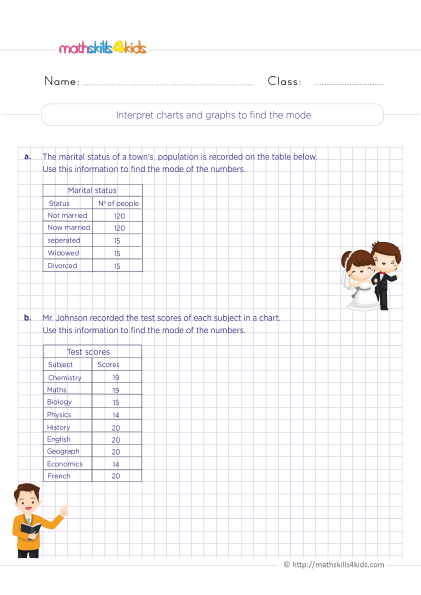 Print it...
Print it...
-
Interpreting charts and graphs to find the mean
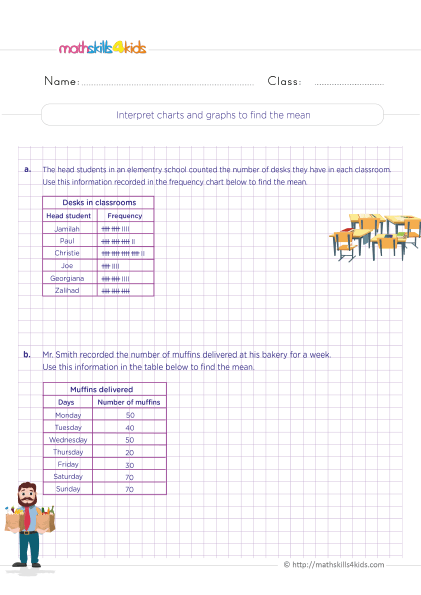 Print it...
Print it...
-
How to find the median of charts and graphs?
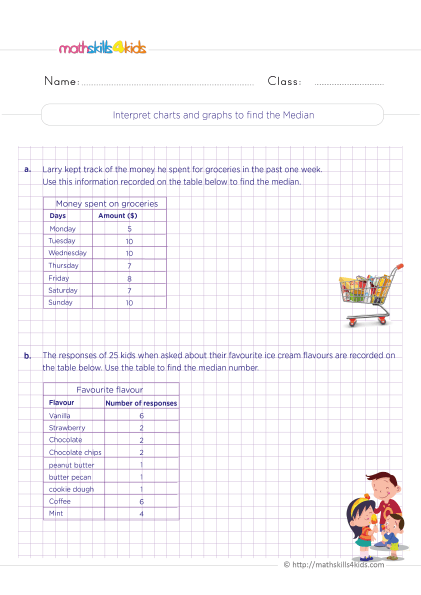 Print it...
Print it...
-
Interpreting charts and graphs to find the range
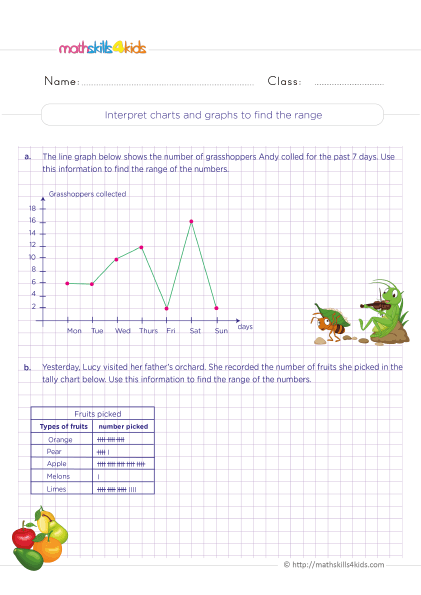 Print it...
Print it...
-
Understanding probability
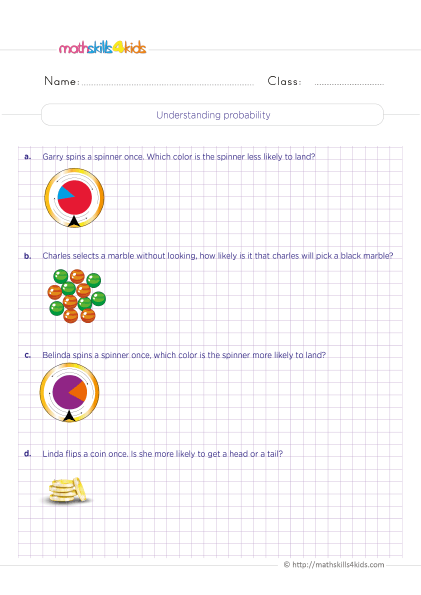 Print it...
Print it...
-
Short stories for making predictions
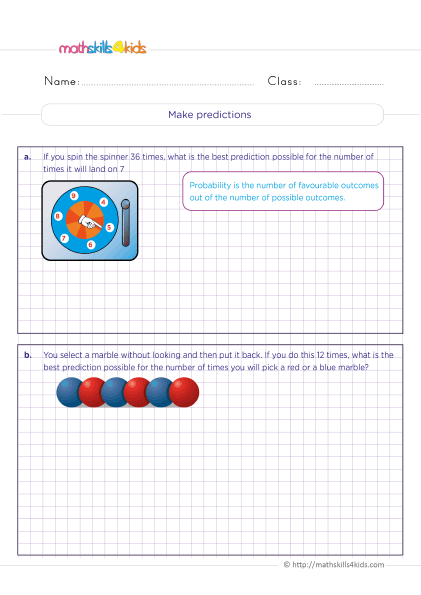 Print it...
Print it...
-
How to find the mode of charts and graphs?
-
Buying is supporting us!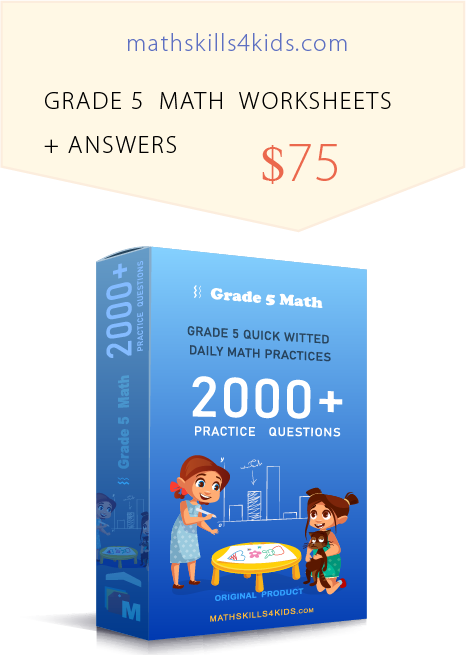
Buy Now...
-
-
Importance of teaching Probability and Statistics in Fifth Grade
Teaching probability and statistics in fifth grade is crucial for several reasons. First and foremost, it helps students develop essential analytical and critical thinking skills applicable in various life areas. Also, understanding probability allows students to make informed decisions based on likelihood, while statistics equips them with the ability to interpret and analyze data.
Most importantly, introducing probability and statistics at an early age helps students build a solid foundation for more complex mathematical concepts in the future. By starting in fifth grade, students have ample time to practice and reinforce their understanding, setting them up for success in higher grades and beyond.
-
Benefits of using worksheets for learning probability and statistics
Using worksheets as a learning tool has numerous benefits when teaching probability and statistics. Firstly, worksheets provide a structured format that allows for organized learning. Students can follow along and complete exercises step by step, ensuring they cover all the necessary topics and skills.
Furthermore, worksheets offer ample opportunities for practice and repetition. Probability and statistics require practice to grasp the concepts thoroughly, and worksheets provide students with a platform to apply their knowledge repeatedly. This repetition reinforces learning and boosts students' confidence in their abilities.
Another advantage of worksheets is their versatility. They can be used in various settings, including classrooms, homeschooling environments, and tutoring sessions. This flexibility allows educators to tailor the learning experience to the specific needs of their students, ensuring maximum engagement and understanding.
-
Types of Fifth-Grade Probability and Statistics Worksheets
When it comes to probability and statistics worksheets, a wide range of options are available to cater to different learning styles and preferences. Some common types of fifth Grade Probability and Statistics worksheets include:
- Probability Tree Diagrams: These worksheets focus on understanding and constructing probability tree diagrams to visualize and calculate probabilities in different scenarios. Students are presented with various situations and will create corresponding tree diagrams and calculate probabilities based on the information.
- Data Analysis Worksheets: These worksheets involve analyzing and interpreting data sets, including bar graphs, line graphs, and pie charts. Students are tasked with answering questions about the data, identifying trends, and making predictions based on the information presented.
- Probability Word Problems: These worksheets present probability concepts as real-world word problems. Students need to read and understand the problem, identify the relevant information, and apply the appropriate probability concepts to solve the problem.
- Probability Games and Puzzles: These worksheets incorporate gamification elements to make learning probability more enjoyable and interactive. Students engage in puzzles, riddles, and games that require them to apply probability concepts to solve problems and advance through the game.
-
Examples of Fun and Engaging Probability Worksheets
To give you a taste of the exciting possibilities our fifth-grade probability worksheets offer, here are a few examples:
- "Roll the Dice" Probability: In this worksheet, students roll two dice and calculate the probability of different outcomes, such as rolling a sum of 7 or an even number.
- "Spinner Probability": This worksheet features a spinner with different colored sections. Students analyze the spinner and calculate the probability of landing on each color.
- "Favorite Ice Cream" Survey: In this data analysis worksheet, students are given the survey results where “fifth-grade students” were asked about their favorite ice cream flavors. Students interpret the data and create a bar graph to represent the results.
- "Marble Jar Experiment": This hands-on worksheet involves conducting a probability experiment using a jar filled with different colored marbles. Students make predictions, conduct the experiment, and record their results to calculate probabilities.
These are just a few examples of the many engaging probability worksheets available. Each worksheet provides a unique learning experience while ensuring students grasp the fundamental concepts.
-
Interactive Activities for Teaching Probability and Statistics
In addition to worksheets, incorporating interactive activities into probability and statistics lessons can enhance students' learning experience. These activities provide a hands-on approach that encourages active participation and deepens understanding. Here are a few interactive activities to consider:
- Probability Experiments: Engage students in conducting real-life probability experiments, such as flipping coins, rolling dice, or drawing cards. This allows them to observe and analyze the outcomes, making connections between theoretical probability and experimental results.
- Data Collection and Analysis: Encourage students to collect and analyze their data. This could involve conducting surveys, measuring and recording various attributes, or observing and recording data from their surroundings. Students can then interpret the data and draw conclusions based on their findings.
- Probability Games: Incorporate probability games into lessons to make learning more enjoyable. Games like "Probability Bingo" or "Probability War" can reinforce probability concepts while providing a fun and competitive atmosphere.
- Virtual Simulations: Utilize online simulations and interactive tools to provide a virtual learning experience. These simulations allow students to manipulate variables, observe outcomes, and make connections between probability and real-life scenarios.
By including interactive activities alongside worksheets, educators can create a dynamic learning environment that caters to different learning styles and keeps students engaged and motivated.
-
How to Incorporate Real-Life Examples into Probability and Statistics Worksheets
Integrating real-life examples into probability and statistics worksheets effectively makes abstract concepts more relatable and understandable for students. By connecting probability and statistics to everyday situations, students can see the practical applications of their learning. Here are some strategies for incorporating real-life examples into worksheets:
- Contextualize Word Problems: When presenting probability word problems, use scenarios that are relevant to students' lives. For example, instead of asking about the probability of drawing a specific card from a deck, ask about the probability of drawing a favorite color marker from a box.
- Use Real Data: When analyzing data sets, use accurate data that students can relate to. This could include data about their favorite sports teams, popular snacks, or classroom survey results. Using familiar data makes students more likely to engage with the material and see the relevance of statistics in their lives.
- Apply Probability to Everyday Situations: Encourage students to apply probability concepts to everyday situations. For example, ask them to calculate the probability of winning a game, the chances of rain on a specific day, or the likelihood of encountering a particular animal at the zoo. This helps students see that probability is not just an abstract concept but something they encounter regularly.
- Invite Guest Speakers: Invite professionals or experts who use probability and statistics in their careers to speak to the class. Hearing real-world applications directly from those in the field can inspire students and demonstrate the importance of probability and statistics in various industries.
Educators can bridge the gap between theory and practice by incorporating real-life examples, fostering a deeper understanding of probability and statistics among students.
-
Tips for Creating Effective Probability and Statistics Worksheets
Creating effective probability and statistics worksheets requires careful planning and consideration. Here are some tips to help you create worksheets that maximize learning outcomes:
- Align with Learning Objectives: Clearly define the learning objectives for the worksheet and ensure that each exercise and question directly relates to those objectives. This ensures that students are focused on the key concepts and skills they need to develop.
- Provide Clear Instructions: Clearly articulate the instructions for each exercise or question. Use simple language and avoid ambiguity to minimize confusion and help students stay on track.
- Gradually Increase Complexity: Start with more straightforward exercises and gradually increase the difficulty level as students progress through the worksheet. This allows for a gradual buildup of skills and knowledge, preventing students from becoming overwhelmed.
- Include a Variety of Question Types: Mix up the question types to engage students and assess their understanding from different angles. Include multiple-choice questions, open-ended questions, and problem-solving scenarios to cater to different learning styles.
- Incorporate Visuals: Use visuals such as diagrams, graphs, and illustrations to enhance understanding and visually represent the concepts being taught. Visuals make the content more accessible and help students visualize abstract concepts.
- Encourage Collaboration: Include opportunities for collaboration and discussion within the worksheet. This could involve group activities, pair work, or class discussions. Collaboration fosters peer learning and allows students to learn from each other's perspectives.
- Provide Answer Keys: Include answer keys or solutions for the worksheets to allow students to self-assess and provide immediate feedback on their progress. This helps students identify areas of improvement and reinforces learning through self-reflection.
Following these tips, you can create engaging, effective worksheets that align with your student's learning goals.
-
Using technology to enhance learning with probability and statistics worksheets
In the digital age, technology can be a powerful tool to enhance learning experiences, including probability and statistics education. Here are some ways to leverage technology when using worksheets:
- Interactive Digital Worksheets: Utilize online platforms that offer interactive digital worksheets. These platforms allow students to complete exercises online, receive instant feedback, and access additional resources to support their learning.
- Online Simulations and Games: Incorporate online simulations and games to provide a dynamic and engaging learning experience. Websites like Math Playground and Khan Academy offer interactive activities and games reinforcing probability and statistics concepts.
- Data Visualization Tools: Use data visualization tools like Google Sheets or Microsoft Excel to create interactive graphs and charts. Students can manipulate the data and explore different scenarios, enhancing their understanding of statistics concepts.
- Virtual Reality (VR) and Augmented Reality (AR): Explore using VR and AR to provide immersive and interactive learning experiences. VR and AR technologies allow students to visualize and interact with probability and statistics concepts in a virtual environment, making learning more engaging and memorable.
By incorporating technology into probability and statistics education, educators can tap into new possibilities and create learning experiences that resonate with today's tech-savvy students.
Resources for Finding Fifth-Grade Probability and Statistics Worksheets
Finding high-quality fifth-grade probability and statistics worksheets can sometimes be a challenge. However, numerous resources are available to help you find worksheets that meet your student's needs. Here are a few resources to consider:
- Educational Websites: Many educational websites offer free and paid worksheets for various grade levels, including probability and statistics. Websites like com, Teach-nology, and Math-Aids.com provide a plethora of options to choose from.
- Textbook Companion Websites: If you use a specific textbook series, check if the publisher has a companion website. These websites often provide additional resources, including worksheets, that align with the content covered in the textbook.
- Teacher Resource Books: Several teacher resource books are available that specifically focus on probability and statistics for fifth-grade students. These books often include ready-to-use worksheets, lesson plans, and teaching strategies.
- Online Communities: Join online communities and forums for educators to connect with fellow teachers and share resources. Websites like TeachersPayTeachers and Pinterest have dedicated sections for probability, and statistics worksheets educators create.
Review and adapt any worksheets to fit your student's specific needs and learning objectives.
-
-
Thank you for sharing the links of MathSkills4Kids.com with your loved ones. Your choice is greatly appreciated.
Conclusion
In conclusion, fifth-grade probability and statistics education can be transformed from a mundane experience to an exciting adventure with the help of fun and effective worksheets.
By using worksheets, educators can engage students, provide ample practice opportunities, and foster a deeper understanding of these essential mathematical concepts.
From probability tree diagrams to data analysis exercises, the variety of worksheets available caters to different learning styles and preferences. By incorporating interactive activities, real-life examples, and technology, educators can further enhance the learning experience and make probability and statistics come alive for students.
Let's make probability and statistics a delightful and valuable experience for fifth-grade students!
